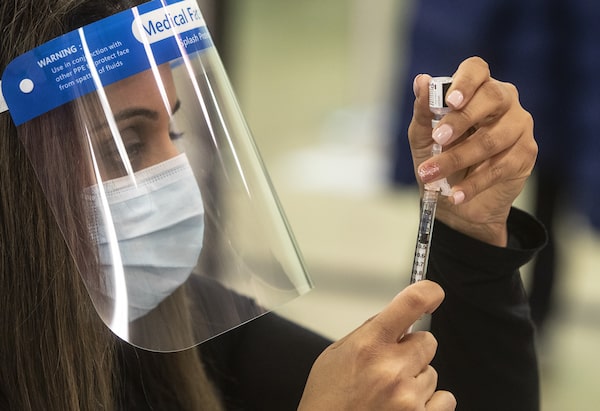
A nurse prepares a dose of a COVID-19 vaccine in Edmonton, on Dec. 15, 2020.JASON FRANSON/The Canadian Press
For Sheron Grayer, the physical side effects of the COVID-19 vaccine were minimal. A few hours after she got home, the injection site on her arm grew sore, persisting for about a day and a half before resolving on its own. It was a similar feeling to when she got her flu shot last fall, she said.
But the emotional effect was profound. Ms. Grayer, a registered practical nurse in Windsor, works in a facility that has become “overrun” with COVID-19 patients during the second wave, and the fear of getting sick and infecting her family weighed heavy on her.
“It lightens my heart to know that when patients are coughing on me, despite having the [personal protective equipment] on, I’m not going to bring it home to my son,” she said.
“Pre-shot, you’re extremely worried about it: Am I going to bring this home to my family? My elderly parents? Even though I’m not 100 per cent clear yet, because I still have to get my second shot, it’s a relief to know I’m on my way there.”
The sore arm Ms. Grayer experienced is the most common side effect of the Pfizer-BioNTech and Moderna vaccines now being distributed across Canada. A Pfizer study found that, seven days after vaccination, 84.1 per cent of vaccine recipients reported at least one reaction at the injection site (most commonly pain or soreness). Redness and swelling were reported less frequently.
By age, 88.7 per cent of people in a younger group (aged 18 to 55) experienced at least one reaction, compared to 79.9 per cent of those over 55. The younger group reported pain more frequently than the older group: 83.1 per cent versus 71.1 per cent respectively after the first dose, and 77.8 per cent versus 66.1 per cent after the second.
The median onset of reactions was between the day of vaccination and two days after, and the reactions typically lasted between one and two days.
Matthew Miller, an associate professor at the Michael G. DeGroote Institute for Infectious Disease Research at McMaster University, said most people who receive the vaccine can expect to feel local soreness or swelling, while a smaller proportion may experience fever, chills, tiredness and headaches.
“Anything more severe than that is very rare,” he said.
Compared to other known vaccines, Dr. Miller said these common side effects fall in between what is typically seen with the flu vaccine on the lower end and the shingles vaccine on the higher end.
Side effects tend to be more pronounced after the second dose, he added.
“The first dose is essentially an initiator dose that primes your system,” Dr. Miller said. “The second dose stimulates a much stronger immune response. A lot of the side effects that we feel after we get a vaccine, including the COVID vaccine, are a function of our immune system becoming activated. So in some ways, it’s a good sign that the immune system is recognizing the vaccine and doing what it’s supposed to be doing.”
The Pfizer study found that 26.1 per cent of recipients aged 18 to 55 reported moderate to severe headaches after the second dose, while Moderna reported that 16.5 per cent of recipients experienced adverse reactions serious enough to disrupt their daily activities.
A few cases of Bell’s palsy, a type of facial paralysis, were reported in trials for both vaccines, but they did not represent a frequency above that expected in the general population and there was insufficient evidence to determine a causal relationship with the vaccines.
Dr. Miller said while it will take time to accumulate data on the potential long-term effects of COVID-19 vaccines, it’s expected that they will be very rare.
“When one thinks about the risk of long-term side effects of a vaccine – in the context of a pandemic, like we’re currently in – the comparison that matters is: What are the rates of any long-term side effects associated with the vaccine relative to the infection? Not relative to unvaccinated people,” he said.
Sherri Pel, a registered nurse in Langley, B.C., said she experienced a “very tender arm” for about one day after receiving her vaccination. For her, the vaccine means less fear of risking her own health – or of those in her household – and that there is a light at the end of the tunnel.
“Every vaccine should be celebrated, because I think we are so privileged to even get this opportunity so quickly,” she said. “Science is just amazing.”
Jacqueline Solomon, a neurologist at St. Michael’s Hospital in Toronto, said she felt “mild arm tenderness” after receiving her first dose of the vaccine. More pronounced, she said, were the feelings of relief and hope after a trying year.
“In some ways, not to sound cheesy or anything, but it felt like I was given a gift,” Dr. Solomon said.
“The concern about side effects is a real concern from the public, and it’s understandable,” she added. “From my standpoint, I would much rather take those very small risks of the side effects with the vaccine than the risk of getting COVID, but at the same time also protecting those around me.”
Dr. Kanna Vela has been treating COVID-19 patients in emergency departments in Ajax and Scarborough, Ontario for nearly 10 months. She lived apart from her family at the onset of the coronavirus pandemic. Receiving her first dose of the Pfizer-BioNTech vaccine in late December has given Dr. Vela some hope for the months ahead as hospitals struggle to care for the rise in COVID-19 cases.
The Globe and Mail
Sign up for the Coronavirus Update newsletter to read the day’s essential coronavirus news, features and explainers written by Globe reporters and editors.
 Andrea Woo
Andrea Woo